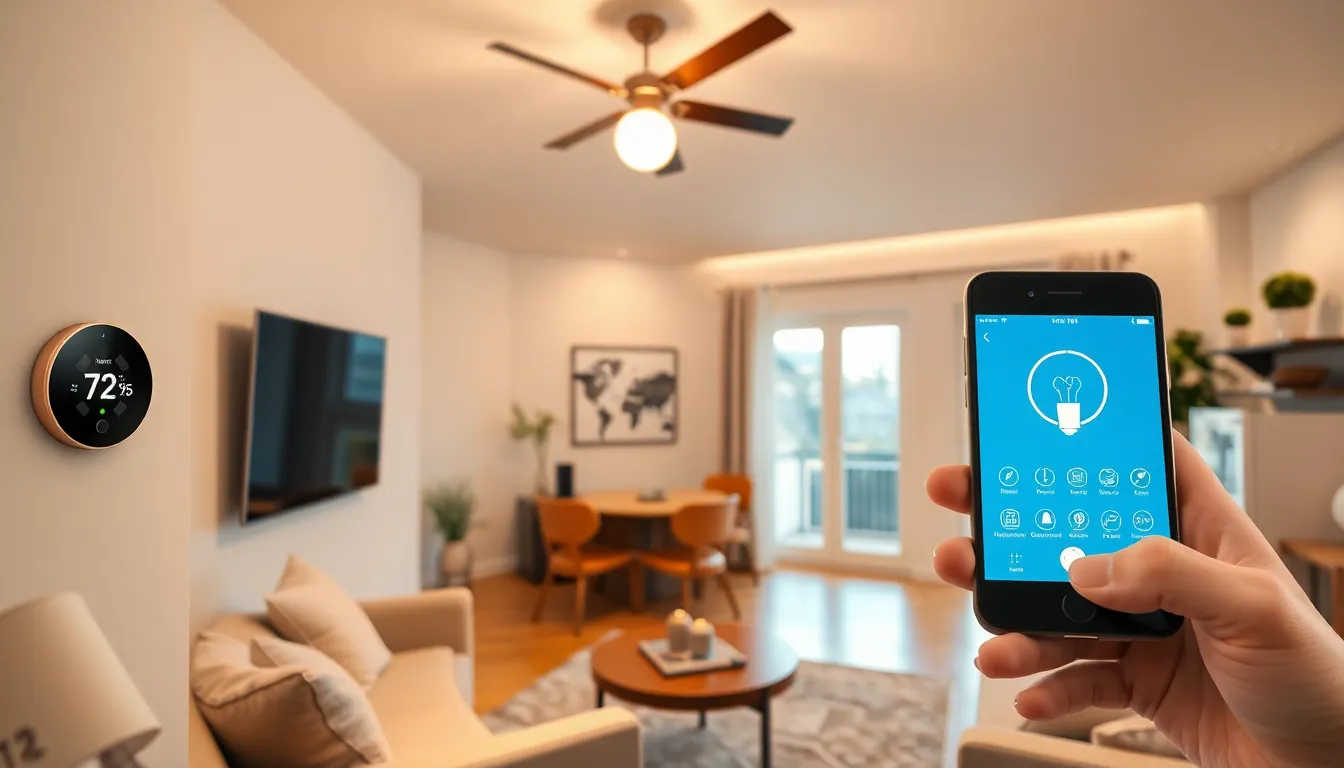In a world where even toasters can connect to the internet, home automation and security have become the dynamic duo of modern living. Imagine a home that knows you better than your best friend—turning on lights as you enter and locking doors behind you like a trusty sidekick. It’s not just about convenience; it’s about creating a fortress that’s smarter than your average bear.
With the rise of smart devices, homeowners can now monitor their spaces from anywhere, even while lounging on a beach or pretending to work at the coffee shop. But don’t let the tech jargon scare you off; setting up a smart home is easier than finding a Wi-Fi signal in your living room. Dive into the world of home automation and discover how it can elevate your security game while giving you the ultimate peace of mind.
Table of Contents
ToggleOverview of Home Automation and Security
Home automation integrates technology within daily living, enhancing comfort and efficiency. It allows users to control various devices remotely, improving convenience in managing tasks. Smart devices, such as thermostats, lights, and cameras, contribute to an intuitive living environment. For instance, motion sensors can activate lights when someone enters a room, adding both functionality and energy efficiency.
Security remains a critical component of home automation. Cameras and alarm systems can provide real-time monitoring, deterring potential intruders. With mobile applications, homeowners can receive alerts and view live feeds from their homes. These innovations make it easier for individuals to keep their residences secure, even when away.
Smart locks add another layer of protection. They can be locked or unlocked from anywhere, streamlining access for trusted guests while enhancing overall security. Furthermore, automation can schedule routine security checks, like locking doors at night or turning on outdoor lights at dusk.
Customization plays a vital role in these systems. Homeowners can create personalized settings tailored to specific needs or preferences. For example, programming security cameras to notify owners of unusual activity increases safety awareness throughout the neighborhood.
Ultimately, the synergy between home automation and security offers peace of mind and enhances daily living. Homeowners can confidently embrace technology, knowing that both convenience and safety are always at their fingertips.
Benefits of Home Automation

Home automation offers various advantages that enhance daily life. It simplifies tasks and provides peace of mind through improved security.
Increased Convenience
Smart home technology boosts convenience for users. Controlling devices like lights, locks, and thermostats remotely becomes effortless through mobile applications. Homeowners can set schedules, ensuring that lights turn on before arriving home. Adjusting temperature settings can happen with a smartphone, providing comfort without manual intervention. Voice-activated assistants add an extra layer of ease, allowing hands-free operation of various devices. Notifications about device statuses keep homeowners informed, so they can manage home elements even while away. This flexibility supports modern living, making everyday tasks smoother and more efficient.
Energy Efficiency
Home automation plays a crucial role in energy efficiency. Smart thermostats optimize heating and cooling based on occupancy patterns. This feature prevents energy waste by adjusting settings when residents are away. With smart lighting, homeowners can schedule lights to operate only when necessary, minimizing electricity usage. Utilizing energy monitors provides real-time feedback on energy consumption, allowing users to make informed decisions. Energy-efficient devices contribute to lower utility bills and reduce carbon footprints. By integrating these technologies, households can promote sustainable living while enjoying savings.
Key Components of Home Automation
Home automation encompasses several key components that enhance convenience, comfort, and security. Smart devices and home security systems play crucial roles in creating a seamless automated environment.
Smart Devices
Smart devices allow quick control of various home functions from a mobile application. Thermostats adjust temperatures automatically based on user preferences. Lights can be programmed to turn on or off according to schedules. Additionally, appliances like refrigerators can notify homeowners about their contents. Voice-activated assistants simplify management, enabling hands-free control. By integrating these devices, homeowners experience improved energy efficiency and personalized settings that align with their lifestyles.
Home Security Systems
Home security systems include cameras, alarms, and smart locks designed to protect properties. Real-time monitoring provides homeowners with immediate alerts for any suspicious activities. Live video feeds accessible via smartphones ensure ongoing awareness. Smart locks facilitate secure access for trusted individuals while maintaining control over entry points. Alarm systems deter potential intruders while offering peace of mind. By utilizing advanced security features, homeowners enhance their safety and confidently manage their household environment.
Integration of Home Automation and Security
Integration of home automation and security transforms residential living. Smart devices work in harmony, creating a seamless user experience. Homeowners access multiple functionalities through a single mobile application, controlling lights, thermostats, and security systems from anywhere.
Real-time alerts enhance security measures significantly. Home security systems provide immediate notifications for suspicious activities, which allows users to respond promptly. Cameras often feature live streaming capabilities, enabling users to monitor their properties remotely, thus reinforcing safety.
Customization offers tailored experiences tailored to individual needs. Homeowners can program security cameras to trigger alerts during unusual activity, ensuring timely reactions. Smart locks simplify access for guests while tightening security, offering a dual benefit.
Energy efficiency complements security systems effectively. Automation of lighting and heating adjusts based on occupancy, reducing energy waste. Homeowners enjoy lower utility bills while maintaining an inviting and secure environment.
Voice-activated assistants further streamline operations. Users command devices hands-free, enhancing convenience, especially when multitasking. Automating routine checks, such as locking doors at night, adds another level of security.
Integration does not sacrifice convenience for safety. Home automation systems prioritize user comfort while ensuring homes remain secure. Balancing these elements creates a well-rounded modern living environment that encourages technology adoption.
Both home automation and security continuously evolve. New technologies emerge, providing more robust solutions tailored to users’ evolving needs. This integration facilitates both peace of mind and energy savings, reflecting advancements in contemporary residential living.
Popular Home Automation Solutions
Home automation offers various solutions that enhance convenience and security. Users can find specific applications, such as smart lighting and smart locks, that provide practical benefits.
Smart Lighting
Smart lighting systems enable easy control over indoor and outdoor illumination. These systems can be programmed to turn on or off automatically based on user schedules or environmental conditions. Users enjoy energy savings since smart bulbs consume less power than traditional lighting. Voice-activated controls make it simple to adjust settings from anywhere in the home. Customization options allow individuals to create different moods with color-changing bulbs. Integrating smart lighting with other devices, such as motion sensors, enhances security by illuminating pathways when movement is detected. This combination results in a safer and more efficient living environment.
Smart Locks
Smart locks offer a sophisticated approach to home security. These locks eliminate the need for traditional keys, providing access through codes, fingerprints, or mobile apps. Homeowners appreciate the convenience of locking or unlocking doors remotely, ensuring peace of mind while away. Alerts notify users whenever a door opens, adding an extra layer of security. Trusted family members or guests can receive temporary access codes, promoting flexibility in entry. Compatibility with home automation systems allows integration with security alarms, enhancing overall safety. As technology advances, smart locks continue to provide innovative solutions for modern homeowners.
Challenges and Considerations
Home automation and security systems face several challenges that homeowners must consider when implementing these technologies. Compatibility issues and privacy concerns stand out as critical factors.
Compatibility Issues
Compatibility among devices often complicates home automation setups. Homeowners find that not all smart devices communicate seamlessly with each other. Vendors create proprietary systems that may not integrate with products from different manufacturers, leading to frustration. Homeowners might invest in devices that cannot easily connect, thus hindering the potential for automation. Determining compatibility before purchasing devices becomes essential. Researching product specifications and seeking devices that adhere to common standards, such as Zigbee or Z-Wave, can help minimize issues.
Privacy Concerns
Privacy concerns represent a significant challenge in home automation. Smart devices often collect personal data, raising questions about information security. Homeowners may worry about how data is used or shared by manufacturers, leading to potential breaches. Protecting sensitive information is crucial, especially with devices that have access to home networks. Implementing strong passwords and enabling two-factor authentication can enhance security. Homeowners must also stay informed about privacy policies associated with their devices to safeguard personal information.
Home automation and security represent a significant leap forward in how people interact with their living spaces. By embracing smart technology homeowners can enjoy enhanced convenience and peace of mind. The ability to monitor and control various aspects of a home from anywhere offers unparalleled flexibility.
While the benefits are substantial challenges exist that require attention. Compatibility issues and privacy concerns must be managed to ensure a seamless and secure experience. With careful planning and informed choices homeowners can create a smart home environment that not only meets their needs but also enhances their overall quality of life. As technology continues to evolve the future of home automation and security looks promising.


